Create Music with Ableton Live 11 on Windows 10/11
Play Music with the Novation Launchpad (Or Other MIDI Devices)
The Complete Beginner's Tutorial for Both
Part Six
Creating an EDM Song (continued)
In Part Five we started creating a basic EDM song, and now we'll pick up where we left off and add more to the song.
Up to this point we've been working in the Session view, creating clips and loops to try out different ideas. Now we'll arrange these ideas into a song using the Arrangement view. On your computer keyboard, press Tab to switch to the Arrangement view:
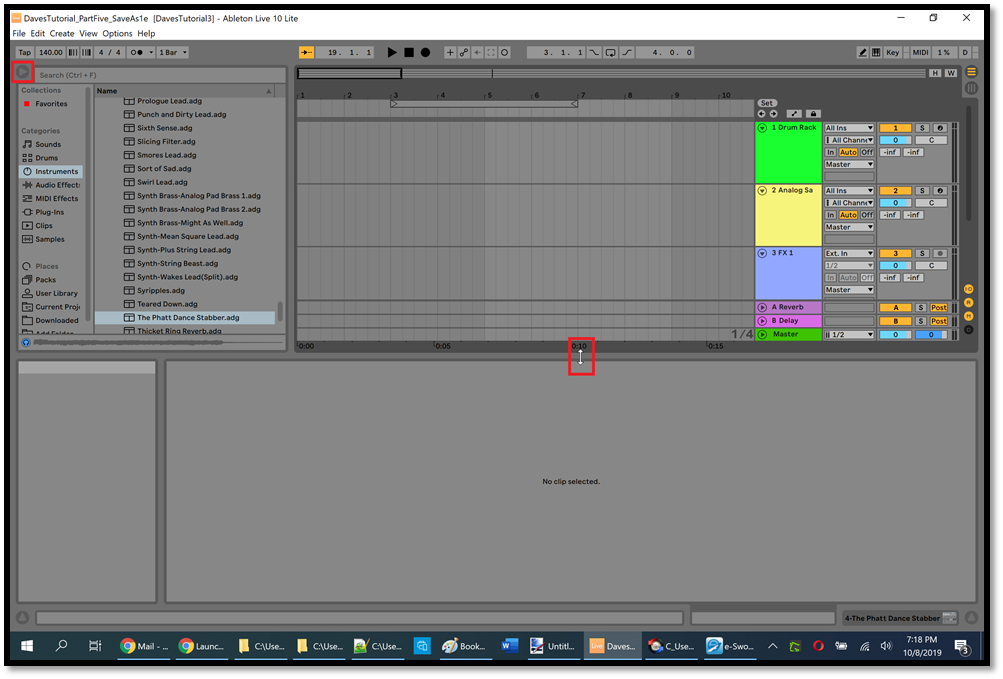
On the right side of the screen you can see the track titles from the Session view, except now the tracks are horizontal. Click the round button at the top left corner of the Ableton Browser (highlighted with a red rectangle in the picture above) to hide the Browser so you can see more of the Arrangement view. Near the center of the picture above, the mouse cursor is highlighted with a red rectangle. Move your mouse cursor to that spot so it changes to an up-and-down arrow, then click and drag downward a bit so you can see more of the Arrangement view.
Notice that there's no music displayed in the Arrangement view. Press Tab to switch back to the Session view, and we'll record our Session view ideas onto the Arrangement view.
Near the top center in the picture below we can see the Stop button (the black square) and the Arrangement Record button (the black circle), both of which are highlighted with a red rectangle. To the left of those buttons we can see "20.1.4" (highlighted with a red rectangle). Those numbers mean that if I click the Arrangement Record button then the music will start recording in the Arrangement view at bar 20, at the 1st beat in bar 20, and at the 4th sixteenth note in the 1st beat. We want to start recording at 1.1.1, and one way to do this is to click the 20 and drag the mouse until it reaches 1, and do the same with the 4. However, a quicker way to return to 1.1.1 is to click the Stop button when there's no music playing, so do that now.
Now we'll record the song by following these steps. Don't worry if you mess up because you can undo the recording and try again. Think of this as a practice run-through:
-
To prepare for recording, click the first Scene Launch button in the Master track (highlighted with a red rectangle at the top right in the picture below), then click the Stop button. The purpose of this is to activate the Play buttons for the first clips in tracks 1 and 2 (as in the picture below). Click the Stop button again to reset to 1.1.1.
-
Click the first clip in track #2 to highlight it so that you can see the yellow icons in the Note Editor (if you don't see the yellow icons in the Note Editor then click Shift+Tab to switch to the Note Editor). In the Note Editor in the picture below, notice the 4 yellow icons at B0. In between the first and second yellow icon there's a vertical black line. That line moves across the Note Editor from left to right while the clip is playing.
-
To start the music playing, click the Arrangement Record button (the black circle highlighted with a red rectangle at the top of the screen in the picture below), and then watch the vertical black line in the Note Editor until it reaches the end of the Note Editor (i.e. the end of bar 1). After it loops back to the beginning, click the second Scene Launch button in the Master track.
-
After the second scene starts playing, click the blueish clip in track #3 to highlight it and watch the vertical black line in the Note Editor. When it's somewhere in bar 4, click the third Scene Launch button.
-
After the third scene starts playing, click the third clip in track #2 to highlight it and watch the vertical black line in the Note Editor. Let it go all the way to the end of bar 4 and loop back around to bar 1. When it reaches the end of bar 4 and loops back to bar 1 the second time, click the Stop button (the black square at the top of the screen).
This might take some practice, so if you mess up while recording then simply click the Stop button and then click the Edit menu and click Undo Record. Then do the above steps again. If you do it properly then you'll have just over 15 bars of music, as we'll see in a moment.
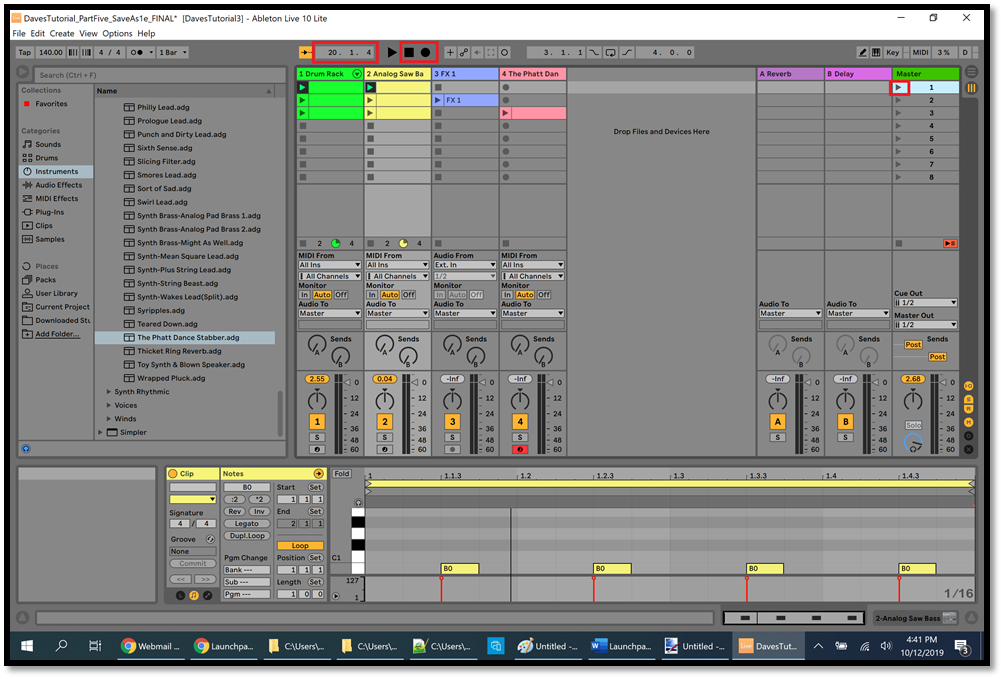
Now you've recorded the song onto the Arrangement view. Press Tab to switch to the Arrangement view, and notice that you have 4 horizontal tracks of music (each track is a different color), but the music is grayed out (your Arrangement view might be zoomed in or out compared to mine):
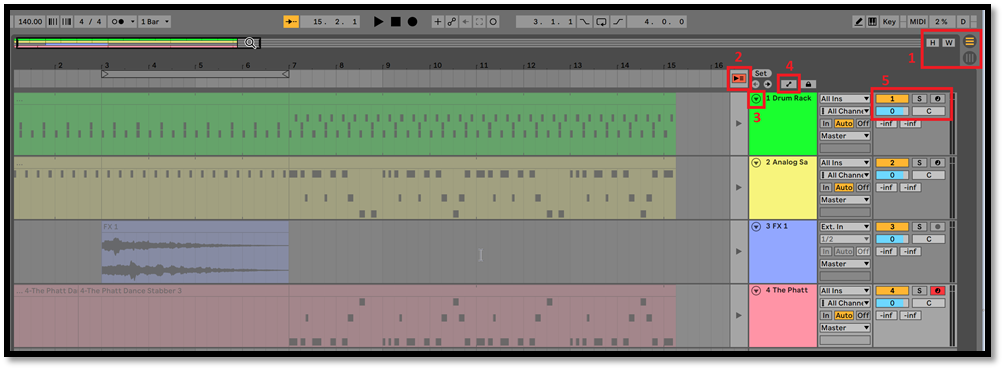
In the above picture, several things are highlighted with red rectangles (the numbers in the picture correspond to the numbers below):
-
At the top right corner of the picture, the "H" button will optimize the height of all of the tracks, and the "W" button will optimize the width of all of the tracks. The 2 round buttons with lines in them will switch between Session view and Arrangement view.
-
The "Back to Arrangement" button is red, indicating that the Arrangement view (that we're in now) has been modified by the Session view (the view that we were in when we recorded the song a moment ago). Click this button so that the music is no longer grayed out, and then you can begin working on your song in the Arrangement view.
-
Each track has a round button with an arrow in it. This allows you to minimize and restore the height of a track. You can also change the height of a track by hovering the mouse over the track and holding down the Alt key on your computer keyboard and using the scroll wheel on the mouse.
-
This is the Automation Mode button, which we'll use in a few moments.
-
These controls are similar to what we saw in the Session view. Turning off the "1" button will mute this track. Turning on the "S" button will Solo this track (muting the other tracks). To the right of the "S" button is the Arm Recording button, which we used earlier in this tutorial. The blue "0" button is the Track Volume button, which you can change by clicking the button and dragging up or down. The "C" button is the Track Pan button. Click this button and drag up and down to make the sounds come out of the left or right speakers.
The next picture is a composite which shows what the mouse cursor looks like at several places in the Arrangement view:
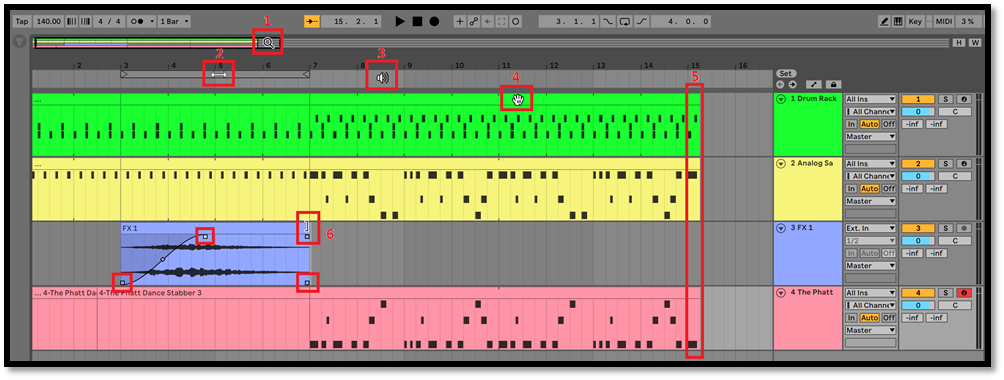
The numbers in the above picture correspond to the numbers below:
-
Starting at the top of the above picture, the mouse cursor looks like a magnifying glass. As we've seen before, when the mouse looks like a magnifying glass then you can click and drag left or right to scroll the music, and you can click and drag up or down to zoom out or in. You can also hold down the Ctrl key on your computer keyboard and use the scroll wheel on your mouse to zoom in or out. You can also press the "=" and "-" keys on your computer keyboard to zoom in or out.
-
When the mouse is over the loop area (the thin horizontal area which stretches from bar 3 to bar 7 in the picture), it changes to a left-and-right arrow. This allows you to click and drag the loop area to any part of the music that you want to loop over and over (so that you can work on a small section of the music, for example). When the mouse is over the loop area and looks like a left-and-right arrow, you can right-click to activate or deactivate the looping. If the loop as activated, then clicking the triangular Play button at the top of the screen will play the section of music in the loop area.
-
When the mouse is just above track #1 and looks like a speaker, if you click the mouse then the music will begin playing at that point. In the above picture, the speaker icon is halfway between bar 8 and bar 9, so if we click at that point then the music will begin playing halfway between bar 8 and bar 9.
-
When the mouse is just above the notes in a track, it changes to look like a hand. This is the title bar for the clip, and you can right-click in this title bar and click Rename to give the clip a name. Clicking the title bar of a clip will highlight the entire clip. Tracks 1, 2, and 4 contain 3 clips, which are the 3 clips from the Session view.
-
When I was in the Session view and I recorded the song onto the Arrangement view, I didn't stop recording at the exact right moment, so I have an extra note or two in each track at bar 15 (if you don't have a little over 15 bars then you might need to re-record the song so that you can continue following this tutorial). If I want to start playing my song at bar 14, for example, to hear that extra note at the end, I can move my cursor to bar 14 until it looks like a speaker (see point #3 above). Then if I click the mouse, the song will start at bar 14.
-
At the top right corner of the blueish clip in track #3, the mouse cursor looks like a square bracket (]). As we've seen before, when the mouse looks like a square bracket then we can click and drag right or left to lengthen or shorten something. For example, we can lengthen or shorten the loop area (#2 above) when the mouse looks like a square bracket at the left or right side of the loop area.
To get rid of the extra notes beyond bar 15, I simply need to put the mouse cursor at the top right corner of the last clip in tracks 1 and 2 and 4 until it looks like a square bracket, then click and drag to the left so that each clip ends just before bar 15.
Notice that the music in tracks 1 and 2 and 4 are all just black rectangles, which indicates that these are MIDI tracks. The clip in track #3 contains squiggly lines, which indicates that it's an audio track. We can use the square bracket to lengthen or shorten a loop in a MIDI track, but we can't use it to lengthen an audio track. We can only shorten an audio track (or return it to its original length).
Just below the square bracket in the clip in track #3 there's a small square, and there are 3 other small squares which are highlighted with red rectangles in that clip. These are the Fade handles, which only appear when you hover the mouse over an audio clip (MIDI clips don't have Fade handles). If you don't see the fade handles then you need to make the track taller by hovering the mouse over the track and holding down the Alt key and using the scroll wheel on your mouse. Clicking and dragging a Fade handle allows you to fade in or fade out the sound in that clip. In the above picture I clicked the top left Fade handle and dragged it to the right a bit so that the clip will fade in when it's played, just for the picture. We don't actually want this clip to fade in for this song.
To play the entire song in the Arrangement view, you can place the mouse so that it looks like a speaker (point #3 above) and click at the beginning of bar 1. Or you can click the square Stop button at the top of the screen once or twice to reset back to 1.1.1, then click the triangular Play button to the left of the Stop button. Play the song all the way through, then click the Stop button after the music ends. Notice how much easier it is to play an entire song in the Arrangement view, because you don't need to launch individual clips or scenes.
Play the song again and listen to the melody. If it's not very loud compared to the other tracks, you can increase the volume of track #4 by clicking the blue Track Volume (which we saw a moment ago) in track #4 and dragging up. Or you can click the blue Track Volumes for the other tracks and drag down to decrease their volume. Adjusting the volumes like this is part of "mixing" a song to get the elements sounding their best together. It's also a way to prevent "clipping," which is when the volume in the Master track goes into the red (as we saw in Part Four).
Now let's work on the drop, which is where we build the tension and then release the tension. One way to build the tension is to make an element of the song (such as the melody) get higher and higher in pitch. Another way is to make an element (such as the drums) go faster and faster. Another way is to use a sound effect which quickly builds and then stops. Another way is to make the sound of part of the song get more and more "trippy." What the heck, let's do all of these.
In track #4, click in the clip title bar (see #4 above) somewhere around bar 11, which will highlight the third clip in track #4. This clip extends from bar 7 to bar 15. Click in the center of that clip at bar 11 (not in the clip title area) to set a marker line, which is a vertical line that flashes white and blue, then right-click that same spot and click Split:

Now the third clip in track #4 has been split into 2 separate clips, as you can see if you click in the clip title area at bar 9 and bar 13. Click in the clip title area at bar 13 in track #4 to highlight the last clip, then press Ctrl+D on your computer keyboard to duplicate the clip.
To build the tension we're only going to use the first half of the clip we just created, so click in the clip title area in track #4 at bar 17 to highlight the last clip in this track, then turn off the Loop button and change the End value to 3 and press Enter (highlighted with red rectangles in the picture below). In Ableton Live 11, those are in the Clip section:

Now the clip is 2 bars long (because we changed the End value to 3), but it still has icons beyond bar 2. These notes won't be played, but let's get rid of them (we'll see why in a moment) by right-clicking anywhere in bar 1 or bar 2 and then clicking Crop Clip.
Click in the clip title area at bar 16 in the last clip in track #4 to highlight the clip, then press Ctrl+D to duplicate the clip. Click in the Note Editor at the bottom of the screen to give it the focus, then press Ctrl+A to highlight all of the icons in the Note Editor, then press the up arrow twice to move the icons up 2 notes. We've now increased the pitch of the melody in this clip.
Let's do that one more time. Click in the clip title area at bar 18 in the last clip in track #4 to highlight the clip, then press Ctrl+D to duplicate the clip. Click in the Note Editor at the bottom of the screen to give it the focus, then press Ctrl+A to highlight all of the icons in the Note Editor, then press the up arrow twice to move the icons up 2 notes.
To add a bit more pizazz to our build-up, click in the clip title area at bar 20 in the last clip in track #4 to highlight the clip, then click anywhere in the Note Editor (but not on an icon) to unhighlight the icons, then move the mouse to the right side of the very last note (the one at G#1) so that the mouse cursor changes to a square bracket (]). Click and drag all the way to the right to extend the last note all the way to the end of bar 3. This is why we cropped the clip a moment ago, in order to delete all of the note icons in bar 3. This clip needs to be 3 bars long, so change the End value to 4 and press Enter. Now you should have this:

To listen to the changes that we just made, move the mouse until it looks like a speaker (see point #3 above) and click at bar 11. We've built up some tension by increasing the pitch of the melody a couple of times and by lengthening the last note.
Now let's add a snare drum to our Drum Rack. Press Shift+Tab on your computer keyboard to see the Device view, then click anywhere in track #1 to see the Drum Rack in the Device view. Click the round button at the top left corner of the Ableton Browser (highlighted with a red rectangle in the picture below) to see the Browser, then click Drums on the left side of the Browser, then expand Drum Hits, then expand Snare, then drag "Snare 70s MPC 2" down to the Drum Rack to the right of "Hihat 808 Close" ("Hihat Closed 808" in Ableton Live 11):
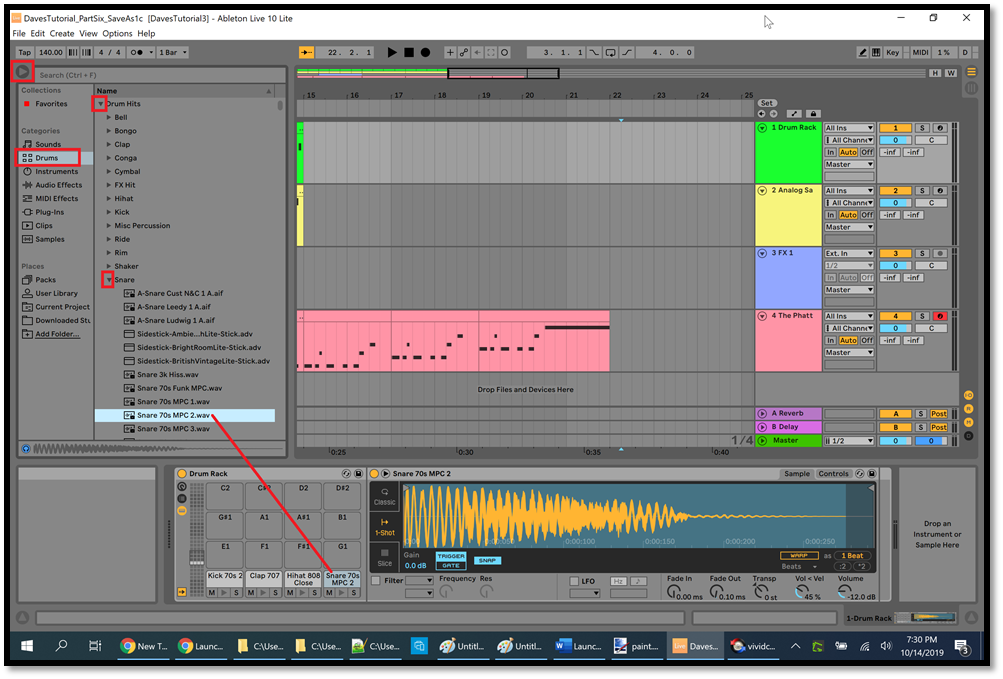
Click the round button at the top left corner of the Ableton Browser (highlighted with a red rectangle in the picture above) to hide the Browser. In track #1, click and drag from bar 21 to bar 22, then right-click in the area that you just highlighted and click "Insert MIDI Clip(s)." This is how you create MIDI clips (of any length) in the Arrangement view:

Right-click in the Note Editor and change the "Fixed Grid" to 1/32. Add the snare drum icons in the Note Editor:
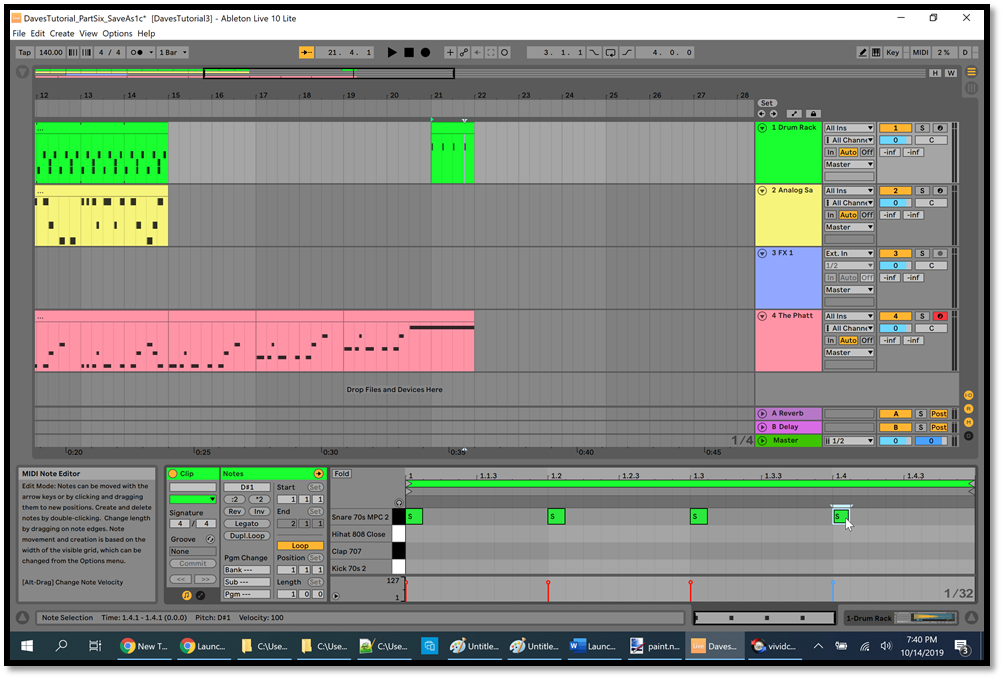
Click in the clip title area in the clip that you just created in track #1, then press Ctrl+D to duplicate it. In the Note Editor for the new clip, add an icon exactly halfway between the existing icons:

Once again, click in the clip title area in the clip that you just created in track #1, then press Ctrl+D to duplicate it. In the Note Editor for the new clip, add an icon exactly halfway between the existing icons. Click in the clip title area in the clip that you just created in track #1, then press Ctrl+D to duplicate it. Now you should have this:
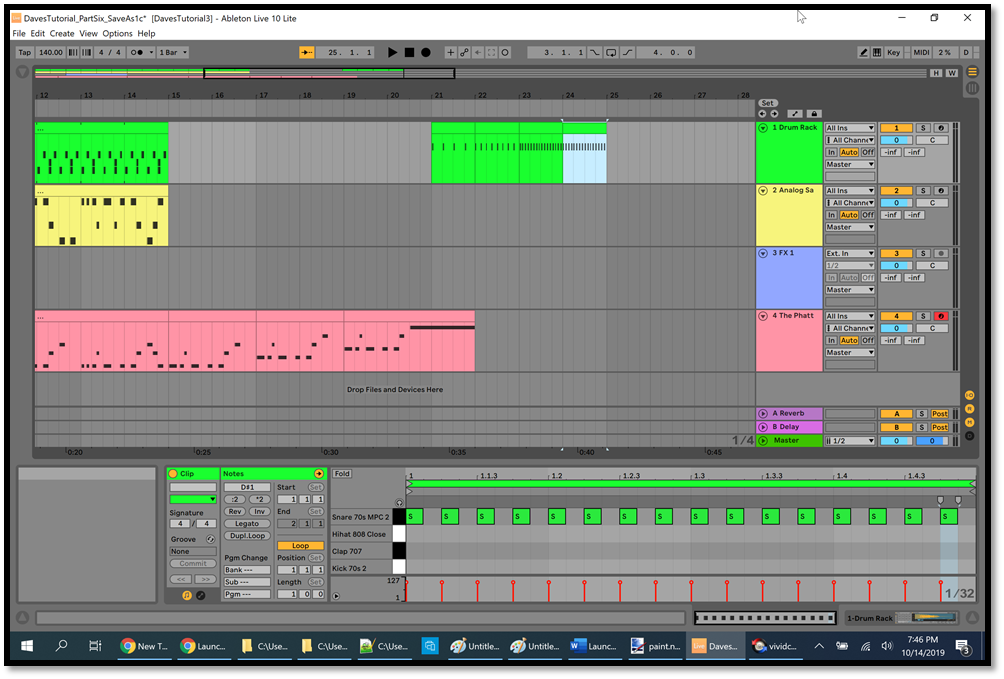
Use the speaker icon (see point #3 above) somewhere around bar 15 (or earlier if you want) to listen to what we've added, and notice that we've built up the tension in 2 different ways. We've increased the pitch of the melody, and we've created a snare drum which gets faster and faster.
If you want to move the snare drum to the left or right to see how it sounds in different positions, you would need to click in the clip title area of each of the 4 snare clips and move them one at a time. Or you can click in the clip title area for the first snare clip, then hold down the Shift key and click in the clip title area for the fourth snare clip so that all 4 snare clips are highlighted, then right-click in the clip title area of any of the snare clips and click Consolidate. This turns them into a single clip, which you can move left or right with the left or right arrow keys on your computer keyboard.
Another method of building up the tension is quite simple. Click in the clip title area for the blueish clip in track #3, then press Ctrl+D to duplicate it. Use the right arrow on your computer keyboard to move the new clip until it begins at bar 24. In the Device view at the bottom of the screen, click the "Rev." button (highlighted with a red rectangle in the picture below) to reverse the clip (in Ableton Live 11 the button looks like a left arrow and right arrow). Use the speaker icon (see point #3 above) and click at bar 25 to hear how the sound effect builds up, then click the Stop button. At the end of the clip it loses the build-up, so move the mouse to the top right corner of the clip until it looks like a square bracket (highlighted with a red rectangle in the picture below), then click and drag to the left until the clip ends halfway between bar 27 and bar 28:
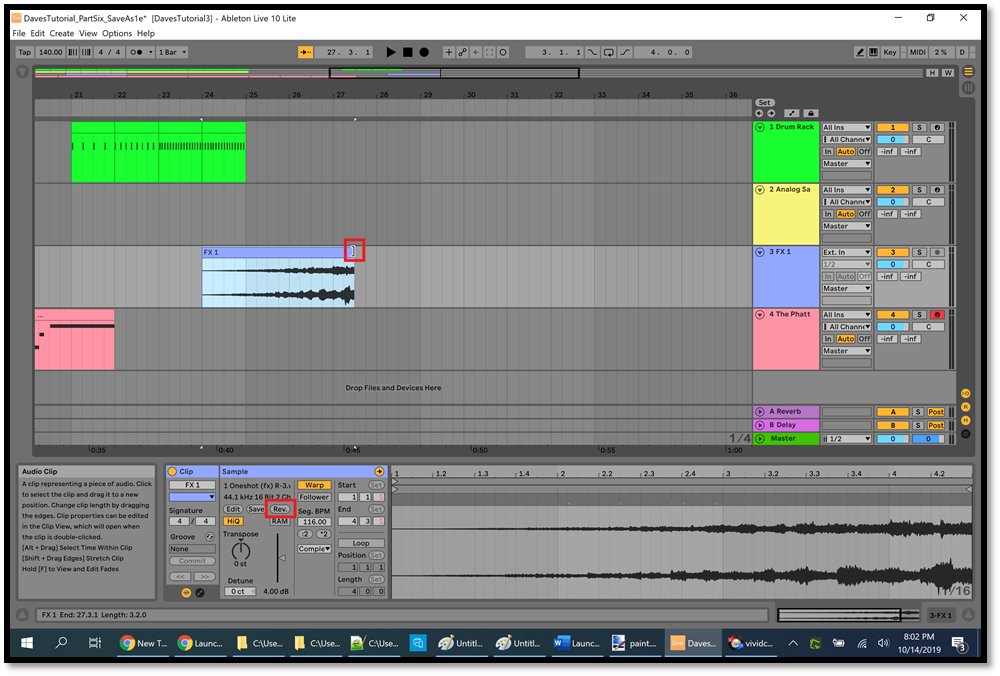
Now the sound effect builds and then abruptly stops, which is what we want for our third method of building up the tension for the drop. Another way to do this is to use a crashing cymbal sound and reverse it so that it builds up to the crash.
For the fourth method of building up the tension, we'll use something called Automation. Open the Ableton Browser using the round button highlighted with a red rectangle at the top left corner in the picture below, then click Audio Effects in the left side of the Browser, then drag Auto Filter anywhere in track #4 (in Ableton Live 11 you'll first need to expand "EQ and Filters"):
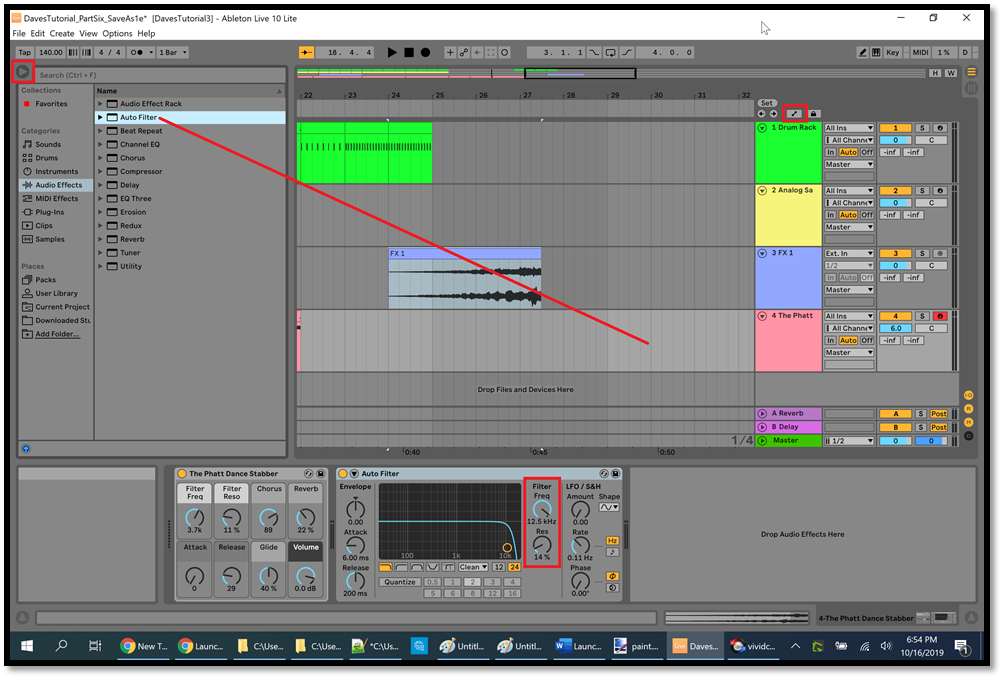
Hide the Ableton Browser again using the round button highlighted with a red rectangle at the top left corner in the picture above. In the Auto Filter, click the "Res." button (highlighted with a red rectangle near the bottom of the picture above) and drag up until it's at its maximum value. Use the speaker icon (see point #3 above) and click at bar 15 to play the music. While the music is playing, click the "Filter Freq" button in the Auto Filter effect (highlighted with a red rectangle near the bottom of the picture above) and slowly drag up and down to hear how it changes the sound. We'll automate these 2 buttons as a simple way of adding a "trippy" sound effect to the melody, but first stop the music and right-click both of those buttons and click Return to Default.
In the above picture, the Automation Mode button is highlighted with a red rectangle just above the Drum Rack track. Turn on this button, and you'll see horizontal red dotted lines in the MIDI tracks. In track #4, select Auto Filter in the first dropdown, and select Resonance in the second dropdown (highlighted with a red rectangle in the picture below). If you don't see both dropdowns then hover the mouse over track #4 and hold down the Alt key on your keyboard and use the scroll wheel on your mouse until you see both dropdowns:
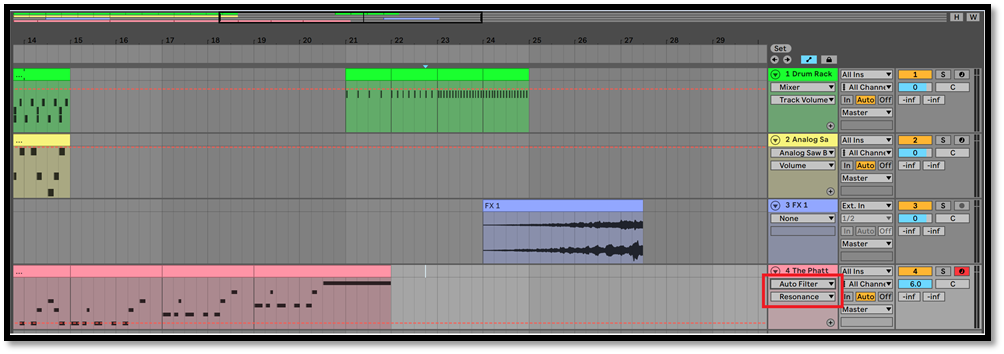
Now we can automate the Resonance button in the Auto Filter effect. To do this, first make sure that the Draw Mode button is off (at the top of the Ableton screen toward the right). Then click the red line in track #4 at bar 15 to create a breakpoint (highlighted with the bottom left red rectangle in the picture below), then click the red line at bar 17 and drag up as far as it will go (highlighted with the top right red rectangle in the picture below), then release the mouse. Now the Resonance button in the Auto Filter will automatically be increased to its maximum value between bar 15 and bar 17:

In track #4, click the dropdown which says Resonance, then select Frequency. Click the red line at bar 17 to create a breakpoint (highlighted with the left-most red rectangle in the picture below), then click the red line at bar 18 and drag down to around 1.05 kHz (highlighted with the middle red rectangle in the picture below), then click the red line at bar 22 and drag up as far as it will go (highlighted with the right-most red rectangle in the picture below). Now the Filter Freq button in the Auto Filter will automatically be modified between bar 17 and bar 22:

Use the speaker icon (point #3 above) and click at bar 15 to hear the "trippy" sound effect that we added as a simple introduction to Automation in Ableton, and watch how the Auto Filter changes between bar 17 and bar 22. When the music ends, click the Stop button. Now we've created the build-up to our drop, using all 4 ideas that I mentioned earlier.
At this point we could create some more drums and bass and melody and so on, but we would just be going over ground that we've covered already. It wouldn't add anything new to the tutorial. Therefore, to keep things simple we'll drag in some drum and melody samples and add a bit of a fade-out to end the song and finish the tutorial.
Open the Ableton Browser (as we did above), then go to the free packs that you downloaded in Part Two, then expand Retro Grain, then expand Retro Grain Project, then expand Retro Grain, then expand Melodic 1, then drag Melodic 3 to the Arrangement view below track #4 (where it says, "Drop Files and Devices Here"). Now you have track #5. Use the right arrow on your computer keyboard to move the clip until it starts at bar 28.
In the Ableton Browser, expand Viral Hip Hop, then expand Viral Hip Hop Project, then expand Viral Hip Hop, then expand 1-Drums 1, then drag Drums 3 to the Arrangement view below track #5 so that it starts at bar 28. Now you have track #6. Press Ctrl+D to duplicate this clip because it's only half as long as the Melodic 3 clip that you placed in track #5.
Hide the Ableton Browser, then turn off the Automation Mode button (highlighted with a red rectangle in the picture below). Now we can see the Fade handles when we hover the mouse over the new clips. Click the Fade handle at the top right corner of the last clips in tracks 5 and 6, and drag them to bar 32 to fade out the music:

Click the square Stop button at the top of the screen once or twice until it resets to 1.1.1, then click the triangular Play button to hear the entire song, then click the Stop button. It's not a very exciting song, but it was useful for demonstrating many features of the Ableton software. Click File/Save Live Set As and then type in a new filename to save the song.
Now that you've had some hands-on experience with the Launchpad and the Ableton DAW (digital audio workstation), Part Seven will provide links to some videos which will take you further in your journey of becoming a music producer.
Part Seven
Modification History
-
November 12, 2023 - Changed the title.
-
July 7, 2023 - Changed the title.
-
December 12, 2021 - Updated the tutorial for Ableton Live 11.
-
October 24, 2019 - New page.
Dave Root
|